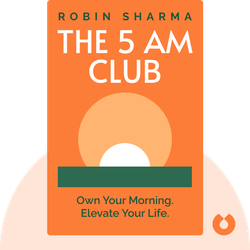Try Blinkist to get the key ideas from 7,000+ bestselling nonfiction titles and podcasts. Listen or read in just 15 minutes.
Start your free trial
Blink 3 of 8 - The 5 AM Club
by Robin Sharma

A new way of looking at human history and psychology
Crowds and Power by Elias Canetti explores the dynamics behind human behavior in crowds, from ancient rituals to modern politics. It examines the relationship between individuals and the group, and how power is found and used in collective actions.
If you’ve ever been running late for work on a crowded commuter train that suddenly grinds to a halt, you might have experienced something like this:
As the train stops, there’s a shift in people’s behavior. Just seconds ago, everyone was immersed in their own small world; now, as frustration mounts, there’s suddenly a sense of togetherness. Everyone’s anger is directed at the same target and everyone wants the same thing – to get the train running again.
That’s a great example of how a crowd forms.
A crowd isn’t just a large number of people – it’s a mass in which members identify with one another. When that happens, people enter into something that’s greater than the sum of their individual parts: a crowd. In that moment, there’s a sense of equality. Every member enjoys the same standing, regardless of previous differences.
Those are the general traits of all crowds, but there are also specific types of crowds. In fact, there are five different kinds of crowd according to their emotional content.
Let’s start with the baiting crowd. This crowd has a clear objective – to kill its chosen target. A classic example is the crowd that called for the crucifixion of Jesus Christ.
Then there are flight crowds. These are formed when a group of people is faced with a common threat. Once the danger passes, however, the crowd dissolves.
Next are prohibition crowds. Their purpose is refusal – think of striking workers manning a picket line.
Reversal crowds are also rebellious, but their aim is to overturn existing power hierarchies. They form when slaves revolt against their masters or soldiers turn their weapons on their officers.
Finally, there are feast crowds. Their purpose? Common and equal indulgence, typically in the form of lavish food-based festivals.
Let’s get back to what all these types of crowd have in common. There are four attributes that define all crowds.
The first is growth. Once a crowd exists, it tends to expand; it “wants” more people to join it.
Second is equality. As soon as a crowd has formed, all its members are equal.
Third, crowds are typically dense. Bodies are pressed up against each other, and nothing can stand in the way of this proximity or divide members from one another.
Finally, every crowd has a goal. Without a purpose, the crowd disperses and people become individuals concerned with their personal affairs once more. Once Jesus had been crucified, for example, the crowd that had been baying for his blood left the scene, and its members returned to their normal lives.



Crowds and Power (1960) is a troubling, prophetic and erudite analysis of human groups and their interaction with power. Written by Nobel laureate Elias Canetti, it asks why humans who prize individuality seek out membership in crowds and how rulers exploit that desire. This study is as wide-ranging in the sources it draws upon as it is thought-provoking in the conclusions it reaches.
Crowds and Power (1960) by Elias Canetti explores the nature of crowds and their influence on human behavior, making it a book that should not be missed. Here's why this book is a remarkable read:
It is certain that man, as soon as he was man, wanted to be more.

It's highly addictive to get core insights on personally relevant topics without repetition or triviality. Added to that the apps ability to suggest kindred interests opens up a foundation of knowledge.
Great app. Good selection of book summaries you can read or listen to while commuting. Instead of scrolling through your social media news feed, this is a much better way to spend your spare time in my opinion.
Life changing. The concept of being able to grasp a book's main point in such a short time truly opens multiple opportunities to grow every area of your life at a faster rate.
Great app. Addicting. Perfect for wait times, morning coffee, evening before bed. Extremely well written, thorough, easy to use.
Try Blinkist to get the key ideas from 7,000+ bestselling nonfiction titles and podcasts. Listen or read in just 15 minutes.
Start your free trial
Blink 3 of 8 - The 5 AM Club
by Robin Sharma
What is the main message of Crowds and Power?
The main message of Crowds and Power is the exploration of the dynamics and psychology behind human crowds and the power they possess.
How long does it take to read Crowds and Power?
The reading time for Crowds and Power varies depending on the reader's pace. However, the Blinkist summary can be read in just 15 minutes.
Is Crowds and Power a good book? Is it worth reading?
Crowds and Power is a captivating read that delves into the fascinating nature of human crowds and their influential force. It is definitely worth exploring.
Who is the author of Crowds and Power?
Elias Canetti is the author of Crowds and Power.